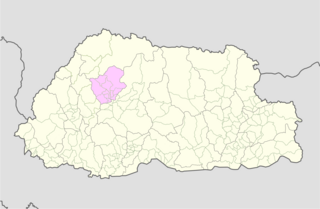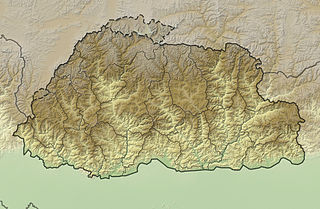
Haa District is one of the 20 dzongkhag or districts comprising Bhutan. An alternative name for the district is "Hidden-Land Rice Valley." It the second least-populated dzongkhag in the country after Gasa.

Chukha District is one of the 20 dzongkhag (districts) comprising Bhutan. The major town is Phuentsholing which is the gateway city along the sole road which connects India to western Bhutan. Chukha is the commercial and the financial capital of Bhutan. With Bhutan's oldest hydropower plant, Chukha hydel, and Tala Hydroelectricity Project, the country's largest power plant, Chukha is the dzongkhag which contributes the most to the GDP of the country. Also located in Chukha district are some of the country's oldest industrial companies like the Bhutan Carbide Chemical Limited (BCCL) and the Bhutan Boards Products Limited (BBPL).

Mongar District is one of the 20 dzongkhags (districts) comprising Bhutan. Mongar is the fastest-developing dzongkhag in eastern Bhutan. A regional hospital has been constructed and the region is bustling with many economic activities. Mongar is noted for its lemon grass, a plant that can be used to produce an essential oil. It also has a hydroelectric power-plant on the Kuri Chhu river. Mongar is notable for having the longest work time in all the dzongkhags of Bhutan.

Punakha District is one of the 20 dzongkhags (districts) comprising Bhutan. It is bordered by Thimphu, Gasa, and Wangdue Phodrang Districts. The dominant language in the district is Dzongkha, the national language.

Samtse District is one of the 20 dzongkhags (districts) comprising Bhutan. It comprises two subdistricts (dungkhags): Tashicholing and Dophuchen. They are further subdivided into 15 gewogs. The Samtse district covers a total area of 1304 km2.

Tsirang District is one of the 20 dzongkhags (districts) of Bhutan. The administrative center of the district is Damphu.
Bji Gewog is a gewog of Haa District, Bhutan. It is the northernmost gewog of the Haa District, bordering China's Chumbi Valley. The gewog has mostly mountainous terrain, with rivers flowing into Amo Chu in the west and the Ha Chu in the east. China claims a large part of the gewog as its territory and has recently started building roads and villages in the border areas.
Sangbay or Sangbaykha Gewog is a gewog of Haa District, Bhutan. It is one of the western gewogs of the Haa district sharing borders with the Samtse District, India's Sikkim state and China's Chumbi Valley. The latter border has been contested by China, which claims the Doklam region as its territory. In recent years, China has begun to build villages in its claimed area.

Dungtoe Gewog is a gewog of Samtse District, Bhutan. Dungtoe Gewog is part of Dorokha Dungkhag (sub-district), together with Dorokha and Denchukha Gewogs.
Mayona Gewog is a former a gewog of Samtse District, Bhutan. It was part of Dorokha Dungkhag (sub-district), together with Dorokha, Dungtoe, and Denchukha Gewogs.

Tading Gewog is a gewog of Samtse District, Bhutan.
Tendu or Tendruk Gewog is a gewog of Samtse District, Bhutan. The Tendruk Gewog comprises part of Sipsu Dungkhag (sub-district), together with Bara, Biru, Lehereni, and Sipsu Gewogs.

Jigme Singye Wangchuck National Park covers an area of 1,730 square kilometres (670 sq mi) in central Bhutan. It protects a large area of the Black Mountains, a sub−range of the Himalayan Range System.
The glaciers in Bhutan, which covers about 3 percent of the total surface area, are responsible for feeding all rivers of Bhutan except the Amochu and Nyere Amachu.

Dophoogchen Gewog, or Dorokha Gewog, is a gewog of Samtse District, Bhutan. Dophoogchen Gewog is part of Dophoogchen Dungkhag (sub-district), which comprise Dorokha and Denchukha Gewogs.
Norgaygang Gewog is a gewog of Samtse District, Bhutan. It is located at the extreme northwest of the Samtse District bordering on India's West Bengal (Kalimpong) and Sikkim provinces. It has the Haa District to the northeast and Samtse's Tendruk Gewog to the southeast.

Pemaling Gewog is a gewog of Samtse District, Bhutan. The gewog has an area of 49.04 square kilometres and contains 15 chewogs with 46 villages and 448 households. Pemaling Gewog comprises part of Tashicholing Dungkhag (sub-district), together with Tendu, Namgaychhoeling, Norgaygang, and Tashicholing Gewogs.
Tashicholing or Sipsu Gewog is a gewog of the Samtse District, Bhutan.

The mountains of Bhutan are some of the most prominent natural geographic features of the kingdom. Located on the southern end of the Eastern Himalaya, Bhutan has one of the most rugged mountain terrains in the world, whose elevations range from 160 metres (520 ft) to more than 7,000 metres (23,000 ft) above sea level, in some cases within distances of less than 100 kilometres (62 mi) of each other. Bhutan's highest peak, at 7,570 metres (24,840 ft) above sea level, is north-central Gangkhar Puensum, close to the border with Tibet; the third highest peak, Jomolhari, overlooking the Chumbi Valley in the west, is 7,314 metres (23,996 ft) above sea level; nineteen other peaks exceed 7,000 metres (23,000 ft). Weather is extreme in the mountains: the high peaks have perpetual snow, and the lesser mountains and hewn gorges have high winds all year round, making them barren brown wind tunnels in summer, and frozen wastelands in winter. The blizzards generated in the north each winter often drift southward into the central highlands.







